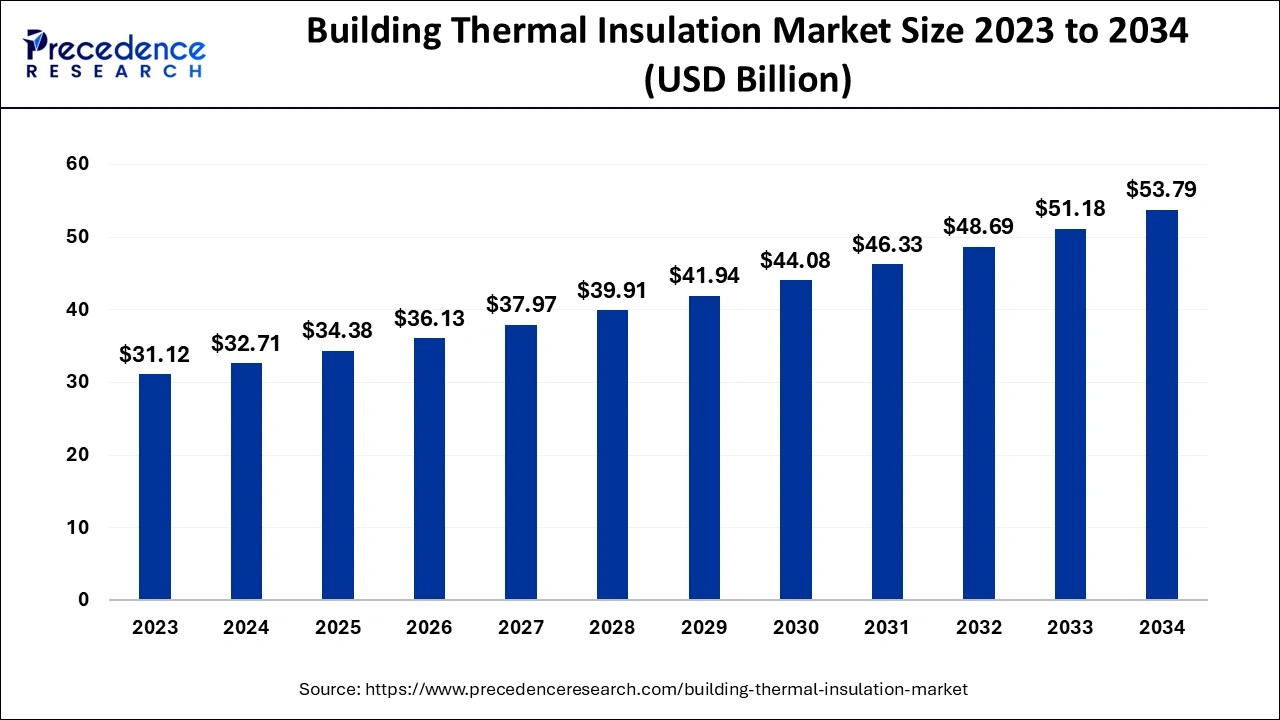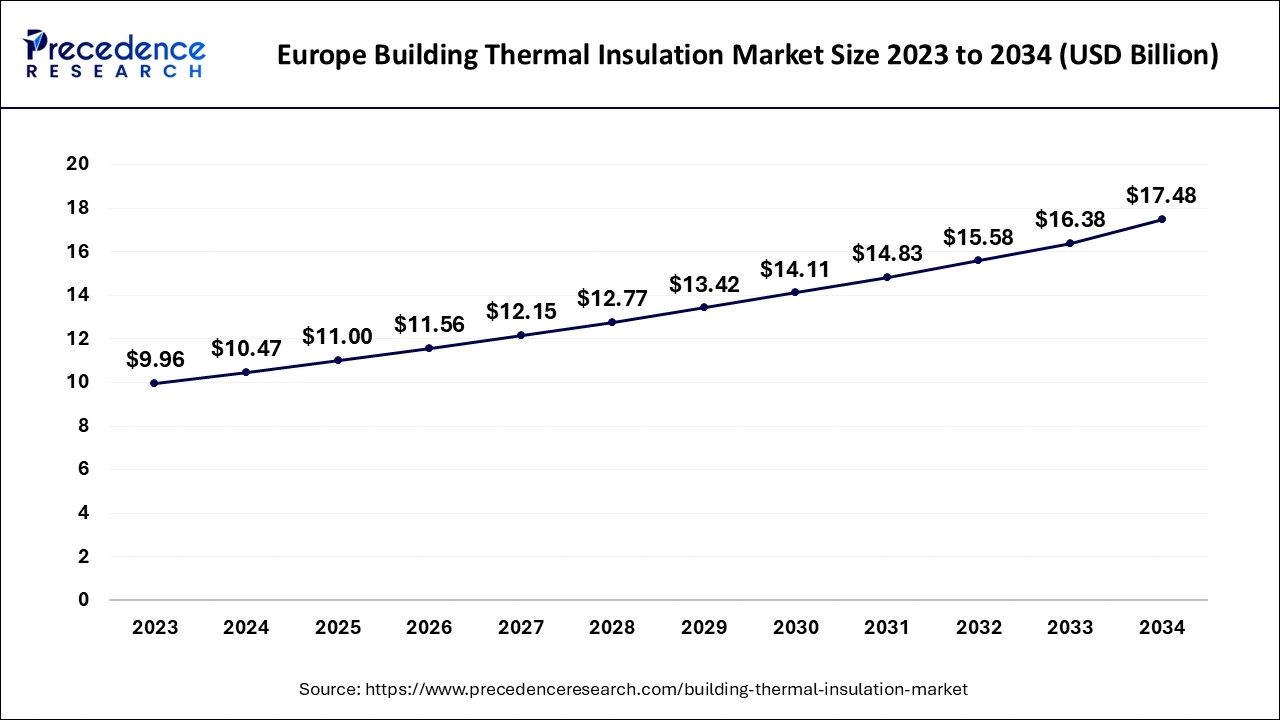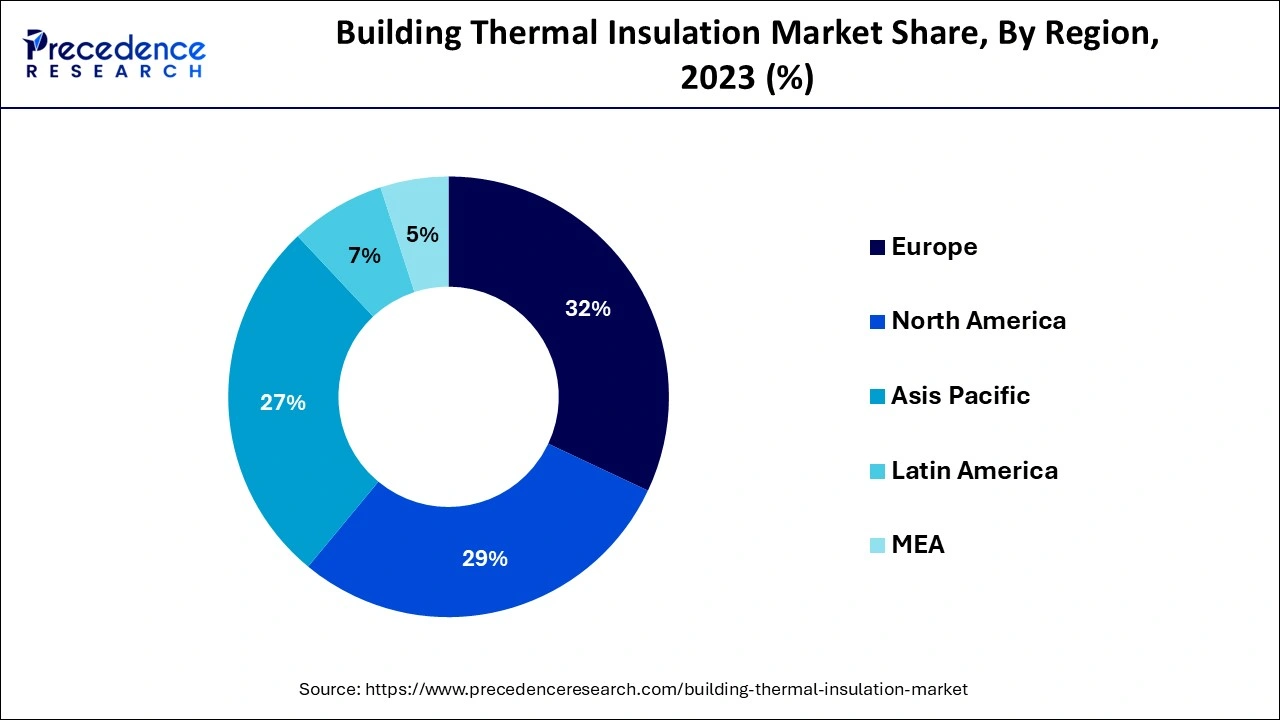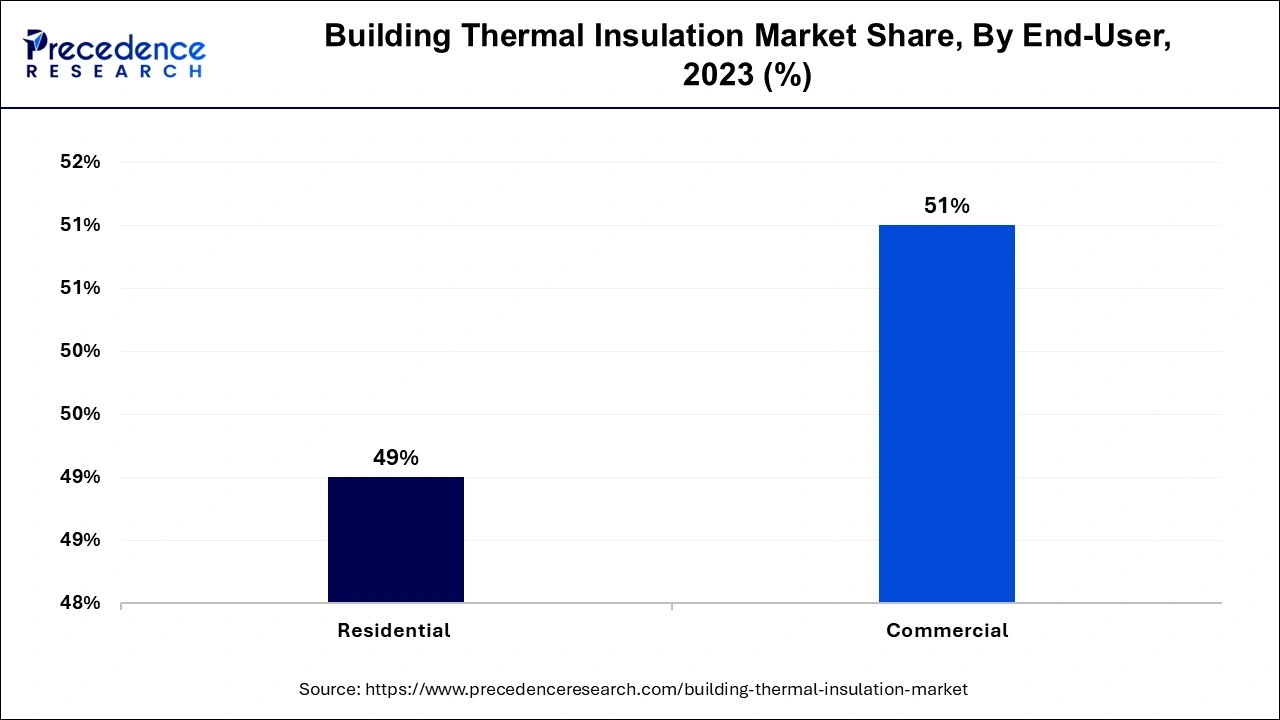September 2024
The global building thermal insulation market size accounted for USD 32.71 billion in 2024, grew to USD 34.38 billion in 2025 and is projected to surpass around USD 53.79 billion by 2034, representing a healthy CAGR of 5.10% between 2024 and 2034.
The global building thermal insulation market size is estimated at USD 32.71 billion in 2024 and is anticipated to reach around USD 53.79 billion by 2034, expanding at a CAGR of 5.10% between 2024 and 2034.

The global building thermal insulation market size is estimated at USD 10.47 billion in 2024 and is anticipated to reach around USD 17.48 billion by 2034, expanding at a CAGR of 5.24% between 2024 and 2034.

Europe is anticipated to influence the Building Thermal Insulation Market. In 2022, the Europe region generated more than 32% of the revenue share and is projected to have the largest share of the market. The energy-saving benchmark by European Commission's and REACH's initiative to promote thermal insulation is anticipated to contribute to regional market expansion.

The rapidly growing construction of residential and commercial building industries in North America and strong green building standards that have been adopted to lower power consumption per structure are projected to fuel market expansion in North America. Furthermore, favorable federal regulations regarding the utilization of the product in commercial and residential facilities are predicted to propel development over the projected time frame.
Due to the remarkably cold weather conditions in Canada as well as some areas of the US, the market in North America is expected to gain the most significant share of the market throughout the projected period.
Thermal insulation in buildings inhibits heat from traveling from one compound to another as they come into thermal contact. Insulation thermal conductivity is measured and achieved by utilizing low thermally conductive substances.
The market's expansion can be caused by the growing use of building thermal insulators to achieve better heat/cold protection. They are widely used in areas with harsh weather for insulating buildings with either heating or cooling systems, as this saves both energy and money. Thermal insulators maintain the temperature inside the building and also save energy on electric heaters. Furthermore, they inhibit extreme cold or heat waves from penetrating the building.
The increasing use of cooling and heating systems in houses is expected to drive market growth. Furthermore, rising energy preservation awareness is projected to fuel market expansion. Global temperature increases, as well as climate change due to different human activities, are also expected to boost the market growth.
| Report Coverage | Details |
| Market Size in 2024 | USD 32.71 Billion |
| Market Size by 2034 | USD 53.79 Billion |
| Growth Rate from 2024 to 2034 | CAGR of 5.10% |
| Largest Market | Europe |
| Base Year | 2023 |
| Forecast Period | 2024 to 2034 |
| Segments Covered | By Material, By Product, By Application and By End-User |
| Regions Covered | North America, Europe, Asia-Pacific, Latin America and Middle East & Africa |
Rising development of green buildings.
The increased development of green buildings is expected to drive the growth of the building thermal insulation industry over the coming years. Green building reduces or eliminates adverse impacts on the climate as well as the natural environment throughout design, construction, and operation. Green structures do not deplete natural resources and improve living standards.
Thermal insulation is utilized in the development of green buildings to produce more energy efficiency and to maintain them cool naturally. For example, as per Times Property, an India-based property purchases, and sale platform, in 2020, the development of green buildings rose in India. Furthermore, according to CBRE, a commercial real estate firm based in the United States, India's total amount of green assets has expanded to nearly 40%.
Furthermore, as stated by the singapore green building council, 49% of singapore's buildings will be green by 2021, and this is expected to rise to 80% by 2030. As a result, the growth of constructing thermal insulation is being fueled by a rise in the development of green buildings.
The adoption of energy certification organizations such as the US Green Building Council (USGBC), as well as Leadership in Energy and Environmental Design (LEED), as well as favorable building codes in the United States and Canada, are projected to increase the need for building thermal insulation.
Increasing global warming as well as climate changes
Air pollution is the primary cause of global warming, which is defined as the occurrence of rising temperatures on the earth's surface as a result of dangerous pollutants generated into our atmosphere as a result of uncontrolled energy use. The significance of improving building energy efficiency for decreasing greenhouse gas emissions, energy consumption, and costs has been widely recognized in Europe, and EU-level obligations for new building energy efficiency demands have been imposed.
Existence of alternative material
Plastic foams as well as recyclable insulation, have been gaining popularity due to strict government laws regulating materials and programs. Rising demand for renewable, biodegradable, and recyclable goods in the commercial and residential industries, as a result of a greater focus on ecological sustainability, is projected to raise the risk of alternatives in the industry over the predicted period.
Due to their poor biodegradability and carcinogenic effects, the US Environmental Protection Agency (EPA) imposed stringent rules on the use of foamed plastics, potentially impeding market growth. Moreover, rising plastic foam expenses are anticipated to restrict market expansion, encouraging the development of alternative materials.
Technological advancement
Technological progress is a crucial trend that is gaining traction in the building thermal insulation industry. Large businesses functioning in the building thermal insulation industry are concentrated on developing novel technologies to achieve a competitive edge. For example, in March 2022, ACC Ltd. introduced the ACC Atrium, a better thermal temperature control concrete system produced using based insulating technology. This unique technology insulates the ceiling while it is being built.
With its thermal insulation, the component is appropriate for both residential and commercial buildings and is sustainable and fire-resistant. The market is also anticipated to increase due to rising usage in spacecraft, aircraft, marine vessels, railcars, and other sectors.
The plastic foam sector held the largest market share in 2023 and is projected to maintain its place throughout the forecast period. Because of its rising use in exterior facade insulation, exterior wall insulation, sandwich panel insulation, and cavity wall insulation, plastic foam is projected to rule the market over the coming years.
Plastic foam's higher compressive strength and energy efficiency, particularly EPS foam, are expected to drive its requirement in building thermal insulation. Versatility, greater thermal resistance (R-Value), strength, and lifespan are key characteristics driving the segment's dominant position in the worldwide market.
The expanded polystyrene sector is anticipated to maintain the largest share between 2024 and 2034. This is because of its long life and excellent thermal insulating materials capabilities. Furthermore, increasing consumer interest in the product due to its rot-proof, recyclable, and non-toxic properties is anticipated to drive growth due to its water resistance, capacity to save energy, and ability to minimize moisture-related damage. Furthermore, growth is anticipated to be assisted by its ability to prevent fungal or microbial development in the insulated area.
The mineral wool sector is anticipated to grow at a significant CAGR from 2024 to 2034. The growth is owing to the unique qualities of the product, such as an efficient heat barrier, environmental compatibility, dimensional stability, and fire safety. Volcanic rocks produce mineral wool like diabase, basalt, and dolomite that are generated in abundance. The increasing need for mineral wool in applications as a thermal barrier is anticipated to propel its growth during the predicted period.
During the projected period 2024-2034, the wall insulation sector is projected to expand rapidly. This is due to an increase in the use of the product on the interior as well as exterior walls. Insulated walls and roofs form a shielded envelope that prevents heat transfer from the outside environment via convection, conduction, and radiation. Mineral and XPS are the two primary materials used for the insulation of external walls because of their low cost, high durability, and ease of installation. Furthermore, higher product permeation for cavity wall insulation is anticipated to encourage market growth.
Floor insulation is anticipated to witness remarkable growth over the projected period due to increasing demand to lower the energy expenses of HVAC functions. Thermal insulation is used in flooring, such as for garages, crawl spaces, cantilevers, and basements. Rising product demand for floor insulation in cold regions is anticipated to propel the growth of the building thermal insulation market.
The residential sector is expected to expand at the fastest pace over the projection period, attributed to the consistent growth of single-family housing, as well as increased refurbishment as well as re-insulation operations of existing and older homes. Moreover, a rise in multi-family residential development activities is expected to support future requirements for building thermal materials.
The increasing significance of energy preservation in public buildings as a result of high energy costs, which also lead to greater maintenance costs, is a significant factor anticipated to contribute to this segment's revenue rise during the projection period.

In 2023, the commercial construction sector accounted for more than 51% of total revenue. The growing importance of public and commercial building energy efficiency because of elevated energy prices that result in higher costs of maintenance is projected to drive growth. Buildings for universities, office spaces, hypermarkets, department stores, supermarkets, shopping malls, restaurants, hotels, hospitals, and resorts are included in this segment. One of the primary drivers behind the expansion of building thermal insulation is the rapidly ongoing trend of sustainable buildings.
Furthermore, rising office space in emerging nations, particularly in the subtropical region, is projected to generate significant demand for insulating materials to maintain energy standardization and regulate temperature levels.
Segments Covered in the Report:
By Material
By Product
By Application
By End-User
By Geography
For inquiries regarding discounts, bulk purchases, or customization requests, please contact us at sales@precedenceresearch.com
No cookie-cutter, only authentic analysis – take the 1st step to become a Precedence Research client
September 2024
September 2024
February 2025
November 2024